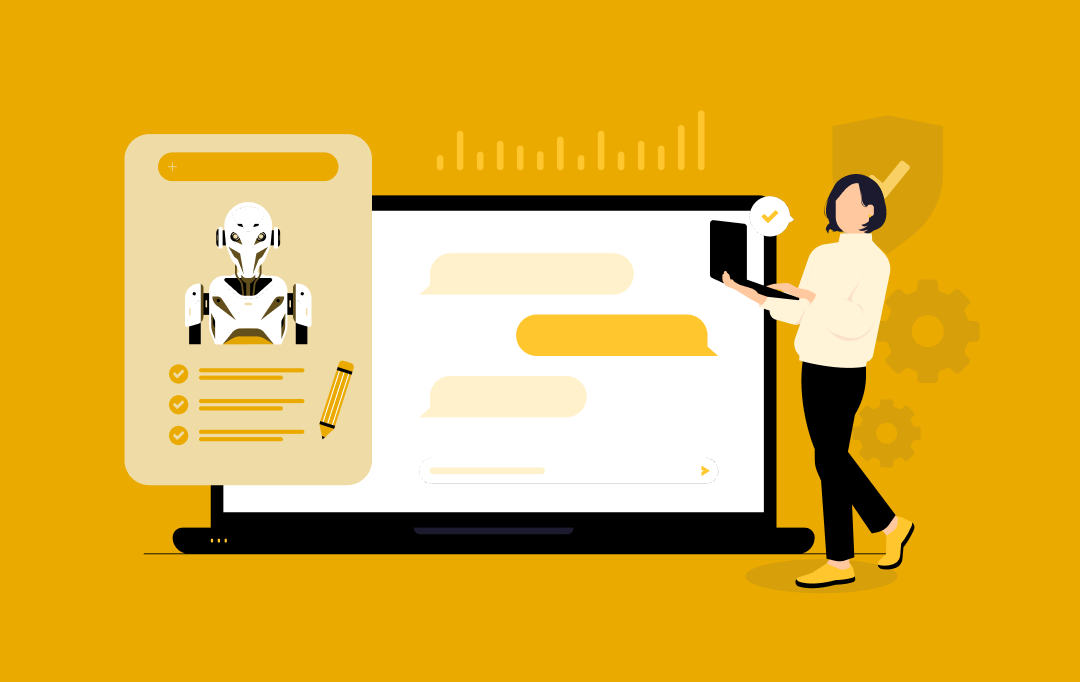- AI in Architecture: Understanding the Technological Impact on the Industry
- Key Benefits of AI in Architecture
- Innovation
- Visualization
- Adaptability
- Historical Insights
- Accessibility
- Customization
- Space Utilization
- Examples and Real-Life Use Cases of Artificial Intelligence in Architecture
- NBBJ's Use of NLP in Design Brief Interpretation
- Gensler's Sketching Optimization
- SOM's Building Energy Management Optimization
- Perkins and Will's Parametric Architecture Innovation
- Jacobs Engineering's Architectural Mapping Improvements
- Quintain's Enhancement of Urban Planning
- AECOM's Generative Design with Autodesk
- Caterpillar's Safety Risk Identification
- AI Implementation in Architecture: Key Steps
- Compile and Prepare Data
- Specify Your Goals
- Choose AI-Related Tools & Technologies
- Create AI Models
- Integrate AI with Design Software
- Establish and Streamline Workflows
- Monitor and Evaluate
- AI in Architecture Challenges and Potential Solutions to Consider
- Data Availability and Quality
- Complexity and Adaptability
- Interoperability
- Security and Privacy
- Implications for Ethics and Society
- Leverage Appinventiv’s Expertise in Implementing AI in Your Architectural Project
- FAQs
Imagine a future when buildings adapt to our demands and maximize efficiency and sustainability through intuitive design. That’s the promise of AI in architecture. Using data analytics and artificial intelligence, architects can now push the limits of precision and creativity. AI enables architects to concentrate on what they do best—imagine and create fascinating spaces by automating repetitive activities, predicting how structures will perform, and generating innovative concepts.
AI technology is revolutionizing the field of architecture and creating exciting new opportunities for the built environment of the future as it advances. This innovation enhances project outcomes, reduces costs, and ensures sustainable practices, paving the way for smarter, more responsive urban spaces.
As per the Royal Institute of British Architects (RIBA)’s 2024 report, 41% of architects worldwide employ AI in their projects. They also strongly agree that AI has significantly enhanced efficiency within their architectural workflows.
In this blog, we will explore the role of AI in architecture, highlighting its benefits, use cases, and implementation challenges. We will also examine how generative AI is revolutionizing the design market, particularly within the architecture industry, and driving remarkable transformations. Let’s take a quick walk through these exciting developments.
AI in Architecture: Understanding the Technological Impact on the Industry
AI in architecture is all about the utilization of artificial intelligence to enhance design, planning, and construction processes, improving efficiency, creativity, and sustainability in building projects. Currently, AI-based architecture is serving as a digital design assistant and utilizing enormous databases to produce efficient, sustainable, and visually attractive structures.
AI’s integration with augmented and virtual reality allows architects to immerse themselves in their designs, refining them with precision. Moreover, AI’s predictive maintenance capability maximizes building operations, guaranteeing sustainability and functionality over the long run. This transformative integration of architecture and AI drives efficiency and innovation within the built environment.
As per a report by Precedence Research, the global generative AI in design market is expected to reach $7,754.83 million by 2032, growing at a CAGR of 34.11% during the forecast period 2022- 2032.
The growing demand for generative AI in the design market is attributed to its capacity to rapidly produce and refine design options, fostering innovation and sustainability. This technology is sought after for its cost-effective solutions, enhanced efficiency, and competitive edge, offering unique design possibilities.
As AI advancements continue, generative AI becomes increasingly sophisticated and accessible, driving its adoption across design and architectural firms globally.
Key Benefits of AI in Architecture
AI for architecture revolutionizes design, optimizing efficiency and sustainability while streamlining project management. Let’s have a look at some of the major benefits of AI in architecture:

Innovation
AI empowers architects to push the boundaries of traditional design by exploring new possibilities and innovative solutions. By utilizing AI algorithms and data analytics, architects can explore eccentric concepts and find new ways to innovate. This ability to think beyond traditional limits can lead to innovative architectural ideas, transforming the built world and offering creative solutions to complex design challenges.
Visualization
AI-powered technologies like AR/VR improve client understanding and engagement by enabling architects to produce immersive visualizations of their designs. These technologies help clients realistically experience the suggested design, see the finished product, and make informed decisions. Moreover, on-site visualization using VR and AR can help with design and construction by allowing architects to superimpose digital models into real spaces.
Also Read: Spatial Computing In The Enterprise – Embracing The Next Frontier Of Digital Innovation
Adaptability
AI integration in architecture allows architects to create structures that can change in response to the needs of their users or the surroundings. By implementing AI-controlled lighting and space allocation systems, buildings can maximize operational efficiency and resource consumption. This flexibility extends the structure’s life and sustainability and improves the occupant’s comfort and well-being.
Historical Insights
Artificial intelligence allows architects to explore historical architectural data and derive insights about previous design trends, material choices, and building methods. By analyzing this data, architects can make better decisions about their present designs and gain a deeper grasp of what has previously worked successfully. This historical viewpoint of artificial intelligence architecture can stimulate new ideas and innovative approaches, resulting in more contextually appropriate architectural solutions.
Accessibility
AI-driven design tools significantly contribute to improving accessibility in architecture by guaranteeing that designs adhere to pertinent accessibility standards and guidelines. These tools can help architects better detect potential obstacles and suggest ways to increase accessibility for impaired individuals.
By adding AI-powered accessibility checks early in the design process, architects can create more inclusive places that serve a wider spectrum of users, encouraging equality and diversity in the built environment.
Customization
Through the use of AI for architecture, architects can create highly personalized designs that meet the needs of particular clients or site circumstances. AI can produce customized design solutions based on user preferences, space constraints, and environmental considerations. With this degree of personalization, architects can provide unique architectural solutions that improve user satisfaction and experience.
Space Utilization
Artificial intelligence is key to ensuring that every square foot of building space is used effectively. AI can make layout and design recommendations that improve functionality by evaluating user preferences, traffic flow, and usage trends. The utilization of AI in architecture enhances the building’s overall user experience while using the available space best.
Examples and Real-Life Use Cases of Artificial Intelligence in Architecture
AI and architecture, when paired together, form a powerful combination that revolutionizes the design, architecture, and construction industry. Here are some of the top examples and use cases of artificial intelligence in architecture.

NBBJ’s Use of NLP in Design Brief Interpretation
By extracting crucial information from design briefs and client communications, Natural Language Processing (NLP) greatly improves architectural processes and guarantees that architects completely comprehend the needs of their clients. The drafting of architectural documentation is automated by AI-driven NLP, which reduces errors and saves time. Additionally, NLP-based chatbots promote knowledge sharing by helping architects find pertinent design resources and information.
NBBJ, an architecture firm, utilizes NLP-based chatbots to enhance internal communication and streamline design documentation. These chatbots enable quick access to and sharing of design knowledge among staff, improving accuracy and overall productivity in architectural projects.
Gensler’s Sketching Optimization
Optimizing sketching with AI is a sophisticated process that enhances architects’ creativity.
Through intelligent design recommendations, AI and architecture, when merged together help architects discover fresh concepts and solutions they might not have thought of before. Additionally, AI forecasts structural performance, enabling architects to make well-informed design decisions early in the process.
Gensler’s approach to utilizing AI for sketching optimization merges human creativity with technological innovation. By leveraging AI, their designers aim to redefine the design and innovation process. This integration allows for faster iterations, new insights, and immediate feedback. Ultimately, incorporating AI into the design process leads to the creation of buildings and spaces that are more sustainable, better performing, and more responsive to individual needs and preferences.
SOM’s Building Energy Management Optimization
To optimize building energy management, AI analyzes real-time data from many building systems and adjusts lighting, ventilation, heating, and cooling settings. This AI-based architecture approach improves energy efficiency by ensuring that resources are used efficiently and only when necessary.
Skidmore, Owings & Merrill (SOM) is leading this innovation by utilizing AI to optimize energy usage in their building projects. Through real-time data, SOM can make well-informed decisions on energy consumption, lowering expenses and having a positive environmental impact.
Also Read: How Do Green AI Applications Support Sustainability?
Perkins and Will’s Parametric Architecture Innovation
With parametric architecture, architects may swiftly and effectively explore a wide range of design alternatives by employing algorithms to automatically construct complex structures and forms based on precise design criteria.
An internationally renowned architecture firm, Perkins and Will, uses AI-driven parametric design tools to produce innovative and sophisticated building ideas. These tools allow architects to explore a multitude of design options, enhance visual appeal, and maximize structural performance.
Jacobs Engineering’s Architectural Mapping Improvements
Artificial intelligence tools are revolutionizing architectural mapping by automating the analysis of geographic data, producing precise and in-depth site maps, and providing insights into the best uses for land and future development opportunities.
Jacobs Engineering Group is using AI-powered technologies to improve architectural mapping. These technologies support improved land use and development strategies, guaranteeing more effective and efficient planning and design by offering accurate site maps and data-driven insights.
Quintain’s Enhancement of Urban Planning
AI significantly contributes to urban planning by analyzing vast datasets related to public infrastructure, traffic, and population density, thereby aiding in developing more sustainable, efficient, and livable urban environments. Delve is a machine learning platform leveraged by Quintain to optimize urban planning by proposing efficient and sustainable layouts.

Quintain has made the best use of Delve to maximize space utilization and infrastructure efficiency, creating better, more livable urban spaces.
AECOM’s Generative Design with Autodesk
AI-driven generative design is a revolutionary approach in architecture that helps architects find the most effective and visually beautiful solutions. It generates many design choices based on predetermined parameters. Furthermore, generative design shortens the concept development process considerably, enabling architects to investigate many design options quickly.
For example, AECOM has integrated Autodesk’s generative design tools into its projects to enhance design efficiency and sustainability. AI-generated design possibilities have enabled AECOM to optimize building layouts, improve structural integrity, and enhance energy efficiency. This advanced approach allows AECOM to deliver innovative and sustainable architectural solutions, demonstrating the transformative potential of AI in the architecture industry.
Caterpillar’s Safety Risk Identification
By examining structural components, materials, and environmental factors, AI detects safety issues in building designs and recommends changes to improve safety and lower risks. Caterpillar, an American construction and engineering equipment manufacturer, leverages AI technology to enhance safety on construction sites.
They employ AI-driven systems to monitor equipment and worker behavior in real-time, identifying potential safety hazards such as unsafe machinery operations or workers entering dangerous zones. These AI systems provide immediate alerts, helping to prevent accidents and improve overall site safety. By integrating AI into their safety protocols, Caterpillar has significantly reduced incidents and ensured safer working conditions on their construction projects.
AI Implementation in Architecture: Key Steps
AI integration in architecture follows certain key steps that guarantee a streamlined and established architectural workflow. Let’s check out the key implementation process of artificial intelligence in architecture.

Compile and Prepare Data
Begin by compiling large-scale datasets, including material properties, environmental conditions, and historical design data. This data provides the inputs required to train AI models. After that, verify accuracy and consistency by cleaning and preprocessing the data to eliminate any errors or unnecessary information.
This step is essential to improving the reliability and effectiveness of AI algorithms. Arrange the data in an organized style to make it easily accessible for analysis and model training. This careful planning lays the groundwork for successfully implementing AI in architecture projects, opening the door to more accurate and creative design solutions.
Specify Your Goals
Establish clear objectives for using AI in architecture design, such as increasing sustainability, automating tedious processes, or maximizing design efficiency. Whether your goal is to reduce design time or create innovative architectural solutions, be clear about what you hope to accomplish with AI.
Set quantifiable goals to monitor the advancement of your AI projects. Involve stakeholders such as clients, engineers, and architects in matching AI goals with project requirements and expectations. Think about long-term goals like AI systems’ scalability and adaptability.
Choose AI-Related Tools & Technologies
Select the right AI tools and technologies, such as data analytics platforms, neural networks, and machine learning algorithms. By weighing your possibilities, determine which tools best suit your unique goals and project requirements.
When evaluating these tools, it’s crucial to consider how seamlessly they integrate with current workflows. Assess their scalability, user-friendliness, and ability to handle large datasets. Additionally, the availability of robust support and comprehensive documentation for these tools and technologies are vital to ensure effective implementation and usage.
Create AI Models
Utilizing the prepared datasets, train AI models to identify patterns, forecast outcomes, and produce design solutions. Start by establishing a reliable training procedure and choosing suitable algorithms. Test these models repeatedly to find any flaws or potential areas for development.
Make necessary parameter adjustments and add new data to improve the models’ accuracy and reliability. Validate the models using actual scenarios to ensure they work well in real-world applications. This continuous development cycle is essential for creating AI models that offer insightful analysis and innovative architectural solutions.
Integrate AI with Design Software
Integrate artificial intelligence models into existing architectural design software, such as CAD and BIM, to enhance usability and functionality. Ensure these AI technologies are compatible with the current software, facilitating easy adoption and smooth workflows. This seamless integration will help maximize the benefits of AI without disrupting established design processes.
This integration allows for real-time design optimization and intelligent decision-making, significantly improving efficiency and creativity in the architectural process. Proper integration is essential to fully utilize AI in architecture and provide the development team with easy access to advanced capabilities.
Establish and Streamline Workflows
AI-powered solutions can reduce human labor and the possibility of error by automating repetitive processes like resource allocation, scheduling, and drafting. By leveraging AI’s analytical capabilities, intelligent systems can generate options that enhance complex design decisions and optimize project workflows.
By implementing these techniques, architects can increase overall project efficiency, improve accuracy, and streamline processes. AI integration boosts creativity and expedites design efficiency, enabling architects to conceptualize and create the built environment.
Monitor and Evaluate
Ensure AI models meet objectives by continuously monitoring their effectiveness and impact on the design process. Gather feedback from stakeholders to identify areas for improvement and refine AI algorithms. This iterative approach enhances AI tools, ensuring their effectiveness and relevance within the architectural context.
Architects can maximize the potential of these technologies by consistently monitoring and evaluating AI performance, leading to more innovative and efficient design solutions.
AI in Architecture Challenges and Potential Solutions to Consider
Integrating AI in architecture and construction offers numerous benefits, but it also presents several challenges. Let’s explore these challenges and examine potential solutions.

Data Availability and Quality
Addressing the lack of standardized, high-quality datasets necessary for training AI models in the architecture sector requires collaboration with data suppliers. Architects can ensure data integrity and enhance dataset diversity and quality through data augmentation methods.
Furthermore, enhancing data availability and quality for AI applications in architecture can be facilitated by putting data governance procedures and agreements into place.
Also Read: Data infrastructure applications and trends in 2024
Complexity and Adaptability
AI systems often find it challenging to mimic the sophisticated decision-making involved in architectural design. Architects can address this challenge by developing AI models that incorporate user feedback and enhance adaptability. This approach enables the system to learn from human interactions and adjust accordingly.
Furthermore, architects can utilize machine learning algorithms to continuously refine and enhance design recommendations based on new information and evolving design criteria. Implementing this approach ensures that AI systems remain flexible and responsive to evolving architectural needs.
Interoperability
Integrating AI tools with current architectural software and workflows can be difficult. Investing in open-source or API-driven solutions that enable smooth system integration can help architects overcome this challenge.
Establishing industry-wide standards for data interchange is crucial to enhancing interoperability. Collaborating with software developers and industry partners to develop standardized interfaces and protocols can significantly improve interoperability, accelerating the integration of AI technology into architecture.
Security and Privacy
Processing sensitive data is a common task for AI systems in architecture, which raises privacy and security problems. Architects can ensure data security and privacy by implementing strong encryption mechanisms, limiting access to sensitive data, and adhering to pertinent laws like GDPR. Frequent upgrades and security audits can also help reduce these threats.
Implications for Ethics and Society
AI for architecture raises concerns about job displacement and bias in design algorithms. Architects can reduce these ethical risks by guaranteeing openness in AI decision-making, implementing bias detection and mitigation strategies, and adhering to moral design principles that prioritize people’s welfare.
To promote ethical and accountable AI deployment in the sector, architects should also push for creating and observing standards and norms for AI use in architecture.
Leverage Appinventiv’s Expertise in Implementing AI in Your Architectural Project
AI has a bright future in architecture and can completely transform the field. It has the potential to significantly increase architecture innovation and efficiency, from improving design processes to optimizing building performance. As architects integrate AI technologies, we may anticipate seeing more user-centered, sustainable designs produced more quickly and precisely.
Appinventiv is a leading AI development company that stands ready to be your partner in leveraging AI for architecture projects. With a proven track record in AI development and a deep understanding of the architectural industry, our experts can help you harness the power of AI in architecture processes.
From concept to completion, Appinventiv can support you in integrating AI technologies that enhance creativity, efficiency, and sustainability in your architectural practice. Connect with our experts to unlock the full potential of AI in architecture and lead the way in shaping the future of architectural design.
FAQs
Q. How is AI used in architecture?
A. AI use in architecture is meant to automate jobs, improve design processes, and forecast building performance. It helps architects to create innovative layouts, maximize energy savings, and simplify processes. AI systems can analyze large datasets to help design choices and enhance buildings’ general sustainability and usability.
Q. What is the future of AI in architecture?
A. AI in architecture appears to have a bright future ahead of it, with several major areas emerging:
Generative Design: AI will allow architects to investigate various ideas and solutions, resulting in more imaginative and effective designs.
Automation: As routine operations in construction and design become more automated, architects will have more time to concentrate on the more strategic and creative aspects of their work.
Performance Prediction: AI’s ability to forecast a building’s energy consumption, structural soundness, and occupant comfort will only get better.
Sustainability: AI will help construct more environmentally friendly structures by maximizing energy use, material selection, and overall environmental impact.
Collaboration: AI will facilitate collaboration among engineers, architects, and other stakeholders, resulting in more integrated and effective design processes.
AI is predicted to transform the architecture industry by empowering architects and designers to work more effectively, sustainably, and artistically.
Q. What is generative AI in architecture?
A. Generative AI in architecture is the application of artificial intelligence to generate design solutions autonomously, given a set of goals and restrictions. Using algorithms, generative AI can investigate a wide range of options, assisting architects in finding creative and efficient design solutions that might not have been considered otherwise.
Q. How does AI impact the role of architects?
A. AI improves workflow and expands architects’ capabilities, enabling them to concentrate more on the creative aspects of their profession by automating tedious chores like paperwork and drafting. By evaluating enormous volumes of data and producing creative design solutions based on predetermined criteria and limits, AI also helps with design optimization.
AI further helps architects with project management by offering insights into budgeting, scheduling, and resource allocation. AI generally helps architects work more productively, explore innovative design options, and provide superior results to their clients.


- In just 2 mins you will get a response
- Your idea is 100% protected by our Non Disclosure Agreement.

How to Integrate AI with EHR/EMR Systems for Streamlined Healthcare Operations
Key takeaways: Not adopting AI in EHR/EMR today risks falling behind. AI streamlines EHR workflows, cutting clinical and admin delays. Real-world hospitals are already seeing faster, smarter care with AI. Seamless AI integration needs system checks, data prep, and training. AI in EHR tackles real challenges like bias, cost, and compliance. Custom AI integration costs…

AI Agent-Driven UIs: Replacing App Menus and Buttons
Key takeaways: Challenge: Static menus and buttons also become outdated because people are frustrated by limited, multi-stage navigation. Solution: The AI Agent interacts with the user through a friendly UI that does not require cludgy menus but conversational and context-sensitive navigation. The Way AI Agents Work: AI agents establish a basis of natural language understanding,…

10 Use Cases and Benefits of How AI Agents Are Revolutionizing the Retail Industry
Key takeaways: AI agents in the retail industry are revolutionizing businesses by enhancing customer experience and streamlining operations. From personalized recommendations to predictive analytics, AI offers tangible benefits like increased conversions and reduced costs. AI adoption can lead to scalable growth and a competitive edge in the retail industry. Retailers must consider data strategies, talent…

















